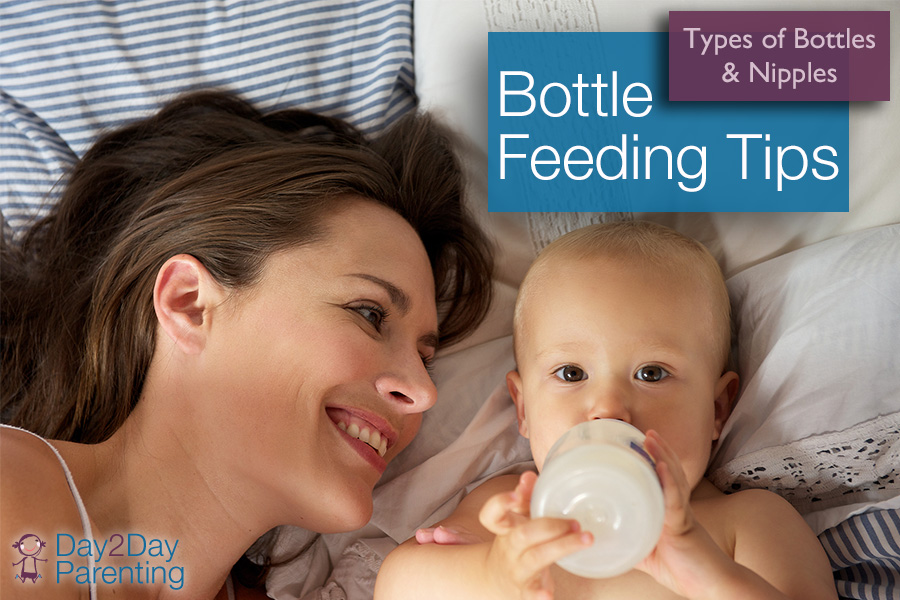In today’s market there are so very many choices for types of bottles and nipples that it can be overwhelming for any parent, especially a first time parent. Often you may have to try a few types of bottles and nipples until you find one that your baby likes best. Once you find the right bottle for your baby, be sure to buy about a dozen to keep on hand.
So what are some pros and cons of the various types of bottles available?
Glass Bottles
- Glass bottles are easier to clean
- Glass bottles last longer than plastic bottles
- Glass bottles can break
- Glass bottles are heavy for babies to hold on their own
- Glass bottles may cost more than plastic
Plastic Bottles
- Plastic bottles are lighter and easier for a baby to hold independently
- Plastic bottles are unbreakable
- Plastic bottles may cost less than glass
- Plastic bottles don’t last as long as glass
- The FDA banned the use of BPA in 2012 from baby bottles
Disposable Bottles
- Disposable liners make bottles very clean and sterile
- Disposable bottles are often more expensive than glass or plastic
- Disposable liners need to always be on hand in order to use these bottles
- One consideration of bottles with liners is the disposal of the liners, and the resulting impact on the environment
- Heating must be performed very carefully and gently with disposable plastic liners
Types of Nipples
Bottle nipples are made to resemble the nipple of a mother’s breast and come in various shapes and sizes. The majority of nipples are made from silicone or rubber. Nipples have different size holes in them in order to adjust the flow from slow to fast.
The best way to find out which nipple best suits your baby is to try a few different types. Once you find the one your baby likes best as far as ease of latching on, sucking and swallowing, buy at least a dozen nipples and bottle covers. Nipples do wear out and become cracked or leaky, so you may need to purchase nipples more frequently than new bottles. Check nipples before each feeding.
Bottle Feeding Basics
Bottle feeding is a wonderful time for nurturing and bonding between parent and child. Find a cozy, comfortable spot in your home and hold your baby in a semi-upright position facing you. Keep your baby’s head in the middle, not tilted to one side or the other to make swallowing easier. Bottle feeding is a great time for eye contact with your baby. Be sure both of your baby’s hands are forward and that one is not tucked beneath you, so she has the chance to try to pat the bottle, grasp onto your fingers and eventually hold the bottle on her own. Always allow plenty of time for your baby to eat, and if possible, minimize distractions.
Test the formula temperature by squirting a few drops onto your inner wrist. Brush the nipple against your baby’s lips and wait for your baby to latch on and draw the nipple in to form a seal. To minimize your baby swallowing air, tilt the bottle, allowing the milk to fill the nipple completely and allow the air to rise to the bottom of the bottle. If your baby gags or chokes during feeding, the nipple flow may be too fast. If your baby is working on sucking too hard during feeding the nipple flow may be too slow. Your baby will show you by his body language when he is done eating. Do not force him to eat more if he turns away, cries or falls into a deep sleep, unless you have been specifically instructed by your physician to wake up your baby for feedings due to low growth. The more you feed your baby the easier it will be to read his cues during feeding. If you have concerns or questions related to bottle feeding, always bring them up to your pediatrician.
DON’TS of Bottle Feeding
- You don’t need to sterilize your glass bottles before each feed; simply sterilize when new and then wash by hand with soap and water to clean.
- Don’t warm bottles in the microwave, use a warm pan of water or simply run the bottle under warm water.
- Don’t prop your child’s bottle for feedings.
- Don’t force your child to feed when he is not interested or not hungry, unless your physician has given you special feeding instructions due to low growth.
- Don’t forget to burp your child at least half way through a feeding or more often.
- Don’t forget to replace bottles and/or nipples that are cracked, chipped or leaky.
Other concerns related to bottle feeding
Seek advice from your pediatrician if your baby spits up frequently and/or forcefully after feedings, which may be an indicator of reflux. Also seek the advice of your pediatrician if your baby seems constipated or has difficulty passing stool or develops any type of allergic reaction or sensitivity to a formula.
Seek the advice of your pediatrician and/or an early intervention evaluation by an occupational therapist or speech therapist trained in infant feeding if your baby has difficulty with coordinating the suck/swallow/breathe pattern, chokes or gags during feedings, loses a lot of liquid during feedings and can’t form a seal on the nipple or has a tongue tie.

